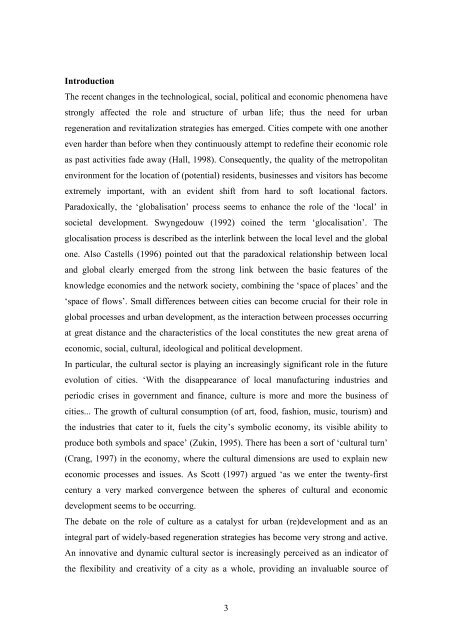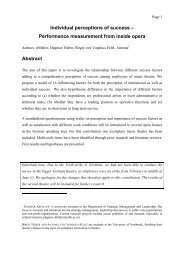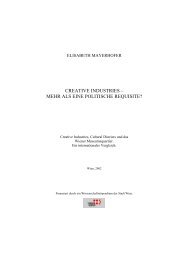Paper - Fokus
Paper - Fokus
Paper - Fokus
You also want an ePaper? Increase the reach of your titles
YUMPU automatically turns print PDFs into web optimized ePapers that Google loves.
IntroductionThe recent changes in the technological, social, political and economic phenomena havestrongly affected the role and structure of urban life; thus the need for urbanregeneration and revitalization strategies has emerged. Cities compete with one anothereven harder than before when they continuously attempt to redefine their economic roleas past activities fade away (Hall, 1998). Consequently, the quality of the metropolitanenvironment for the location of (potential) residents, businesses and visitors has becomeextremely important, with an evident shift from hard to soft locational factors.Paradoxically, the ‘globalisation’ process seems to enhance the role of the ‘local’ insocietal development. Swyngedouw (1992) coined the term ‘glocalisation’. Theglocalisation process is described as the interlink between the local level and the globalone. Also Castells (1996) pointed out that the paradoxical relationship between localand global clearly emerged from the strong link between the basic features of theknowledge economies and the network society, combining the ‘space of places’ and the‘space of flows’. Small differences between cities can become crucial for their role inglobal processes and urban development, as the interaction between processes occurringat great distance and the characteristics of the local constitutes the new great arena ofeconomic, social, cultural, ideological and political development.In particular, the cultural sector is playing an increasingly significant role in the futureevolution of cities. ‘With the disappearance of local manufacturing industries andperiodic crises in government and finance, culture is more and more the business ofcities... The growth of cultural consumption (of art, food, fashion, music, tourism) andthe industries that cater to it, fuels the city’s symbolic economy, its visible ability toproduce both symbols and space’ (Zukin, 1995). There has been a sort of ‘cultural turn’(Crang, 1997) in the economy, where the cultural dimensions are used to explain neweconomic processes and issues. As Scott (1997) argued ‘as we enter the twenty-firstcentury a very marked convergence between the spheres of cultural and economicdevelopment seems to be occurring.The debate on the role of culture as a catalyst for urban (re)development and as anintegral part of widely-based regeneration strategies has become very strong and active.An innovative and dynamic cultural sector is increasingly perceived as an indicator ofthe flexibility and creativity of a city as a whole, providing an invaluable source of3




